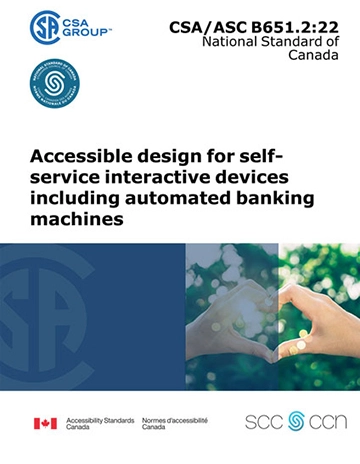Preface
This is the first edition of CSA/ASC B651.2, Accessible design for self-service interactive devices including automated banking machines. It supersedes the second edition of CSA B651.1, published in 2009 under the title Accessible design for automated bank machines, and the first edition of CSA B651.2, published in 2007 under the title Accessible design for self service interactive devices.
This new edition of CSA/ASC B651.2 includes the following major changes:
a) consolidation of CSA B651.1 and CSA B651.2, as noted above, into one new standard;
b) updates to the contents of both standards noted above; and
c) improvements to the standard on access to devices.
This Standard is intended to be used in conjunction with CAN/CSA-B651.
The requirements of this Standard are minimum requirements. This Standard does not have the force of law unless mandated by legislation or referenced in the regulations of the authority having jurisdiction. The user is advised to contact the authority having jurisdiction in order to determine to what extent this Standard is referenced.
This Standard was prepared by the CSA Subcommittee on Accessible Design for Self-Service Interactive Devices and ABMs, under the jurisdiction of the CSA Technical Committee on Accessibility and the CSA Strategic Steering Committee on Community Safety and Well-Being, and has been formally approved by the Technical Committee.
This Standard has been developed in compliance with the Standards Council of Canada requirements for National Standards of Canada. It has been published as a National Standard of Canada by CSA Group.
Scope
1.1 Purpose
This Standard specifies minimum accessibility requirements for self-service interactive devices (such as, but not limited to, automated banking machines, retail self-checkout, self check- in devices, ticket vending kiosks, smart card sales, query and reload devices).
Note: While the purpose of this Standard is to make a product as accessible and usable as practicable, it is possible that some people will have needs greater than or different from the needs addressed by this Standard, and having the ability to interact with a person can be supportive. See Annex A for common design barriers for people with disabilities.
1.2 Application
This Standard specifies technical requirements applicable to the design, manufacture, site preparation, and installation of self-service interactive devices.
1.3 Limitations
This Standard does not cover
a) physical environment of drive-through self-service interactive devices; and
b) websites and web applications that are beyond the control of the service provider and accessed from public devices.
1.4 Terminology
In this Standard, shall is used to express a requirement, i.e., a provision that the user is obliged to satisfy in order to comply with the standard; should is used to express a recommendation or that which is advised but not required; and may is used to express an option or that which is permissible within the limits of the Standard.
Notes accompanying clauses do not include requirements or alternative requirements; the purpose of a note accompanying a clause is to separate from the text explanatory or informative material.
Notes to tables and figures are considered part of the table or figure and may be written as requirements.
Annexes are designated normative (mandatory) or informative (non-mandatory) to define their application.
1.5 Alt text
Alt text is provided in the captions associated with figures and tables.



